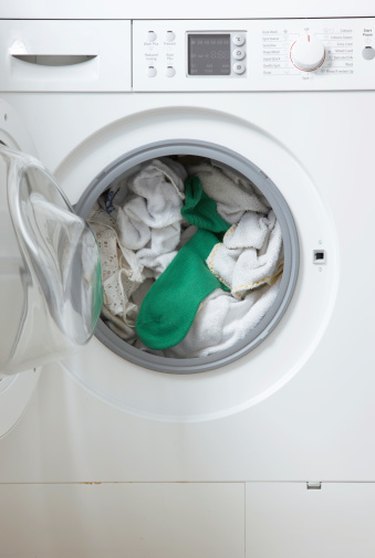
Washing machines come in a variety of styles manufactured by numerous appliance makers. Some brands offer models equipped with custom features including extended spinning, or automated detergent and fabric softener dispensers. While technology allows for additional features and cycle variations, the basic steps of the wash cycle remain consistent.
Prewash
Video of the Day
The prewash step includes filling the washing machine's tub with water and mixing in the detergent. Oftentimes the prewash entails allowing the load to soak for a while to loosen dirt and begin to remove stains that otherwise might not be cleaned during a normal wash cycle. Front-loading washing machines and top-loaders use different methods for determining the water level for a given load. Front-loading washers rely upon the setting designated by the user. Current model top-loaders are equipped with water level sensors to fill the tub with the amount of water necessary to clean the load, and no more.
Video of the Day
Washing
During the wash cycle, the machine uses agitation to mix the water and detergent, as well as to move the clothing around the tub--and against other clothing--to clean the load. Top-loading washing machines often contain an agitator in the middle of the tub to move the load in alternating directions, while front-loaders rely upon the rotation of the entire tub to provide the agitation necessary for cleaning. The duration of the wash cycle varies among washer types and the setting chosen by the user. The wash cycle for heavy cleaning (for tougher jobs) will last longer. Light cleaning cycles are shorter in duration.
Rinsing
Rinsing the load is usually a multi-step procedure. First, the soapy water must be spun from the clothing and wash tub. During the latter minutes of the purging, fresh water is sprayed into the tub to rinse the clothing. The rinse cycle uses intervals of spraying and spinning to force the soapy water and detergent out of the washer. A final stage of agitation with plain water is the last step in rinsing and the beginning of the final step: spinning.
Spinning
Spinning is necessary for wringing the clothing, getting it as dry as possible before the end of the wash. Oftentimes, water is sprayed into the wash tub to completely rinse the clothing before it's finally spun to its driest point. Washing machines spin at different speeds. Your washing machine's spin cycle speed will be represented in the accompanying manual or sales literature by "RPM." The RPMs--or revolutions per minute--indicate the speed with which the tub spins to extract the water from the laundry. Commonly, the faster the spinning the dryer the clothing will be and the least amount of effort is needed to dry the clothing in your dryer.